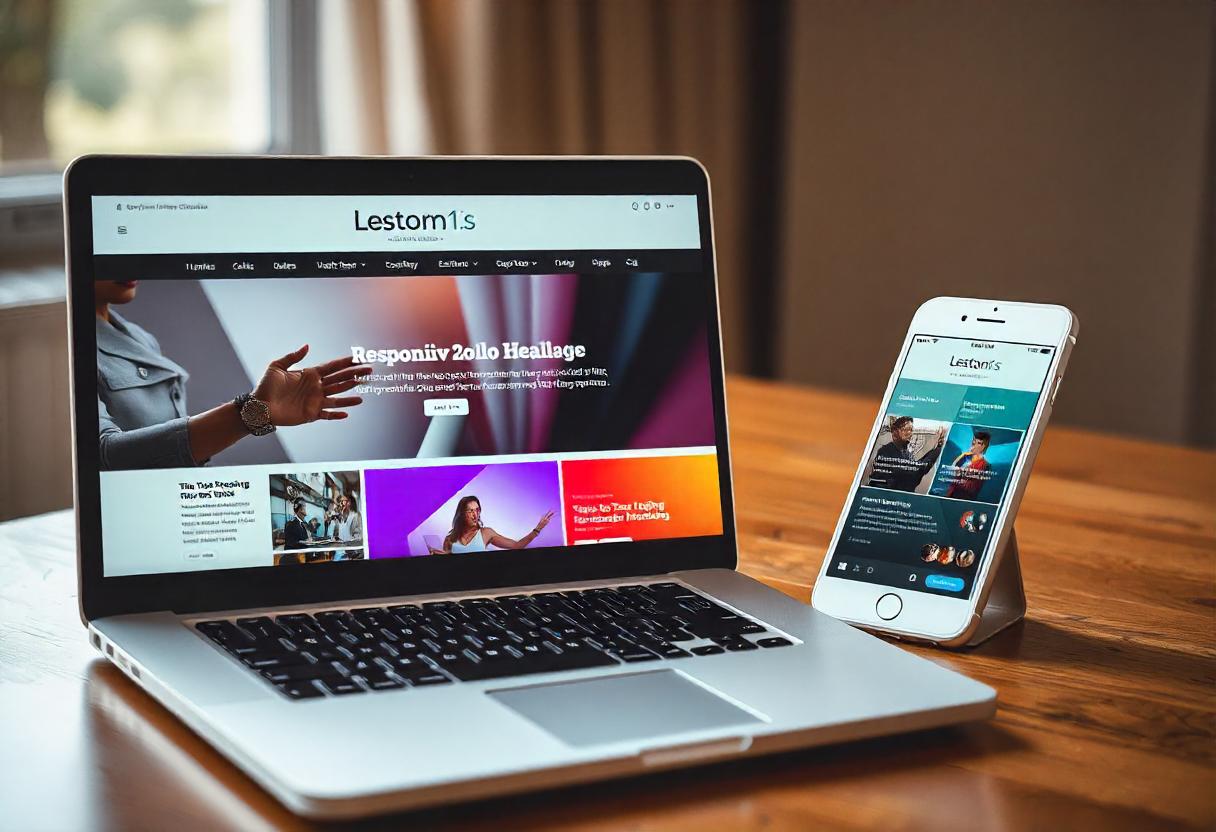
In today’s digital world, a well-designed blog is essential for standing out in a crowded content landscape. As a blogger, your website’s design is more than just aesthetics; it’s about functionality, usability, and creating a seamless experience for your readers. In this comprehensive guide, we’ll explore everything you need to know about web design for bloggers, including practical tips, critical elements of a great blog design, and how to improve your site’s performance and user experience.
Why Web Design is Crucial for Bloggers
The design of your blog significantly impacts readers’ experience and the overall success of your content. Here’s why web design matters:
First Impressions Matter
Visitors form an opinion about your website within seconds of landing on it. A clean, professional design can establish trust, while a poorly designed blog might turn readers away, lowering engagement.
User Experience (UX)
A blog with poor navigation or slow loading speeds will frustrate visitors, leading to a high bounce rate. Great UX, on the other hand, increases engagement and encourages users to stay longer and explore more of your content.
SEO and Performance
A well-designed blog doesn’t just look good; it performs well. Fast loading times, mobile responsiveness, and user-friendly navigation are all factors that improve your search engine ranking and user engagement.
Building Brand Authority
A blog’s design reflects its brand identity. A cohesive, professional design enhances credibility and helps establish authority in your niche.
Critical Elements of a Great Blog Design

Creating an exceptional blog design involves more than just choosing a theme. These essential elements work together to create a functional and visually appealing site.
1. Mobile Responsiveness
With mobile usage increasing, ensuring your blog is mobile-responsive is essential. Your site should adjust to different screen sizes to provide a smooth browsing experience on any device.
Why Mobile Optimization Matters
Google prioritizes mobile-first indexing, meaning that if your blog is not mobile-friendly, it could harm your SEO rankings. Additionally, mobile optimization improves user engagement, making it crucial for success.
2. Clean Layout and Simple Design
A minimalist design with ample white space makes content more accessible to read and improves user experience.
Avoid Clutter
Too much content, pop-ups, or ads can overwhelm visitors. Stick to essentials, ensuring your blog remains visually appealing and easy to navigate.
3. Fast Load Time
Page speed is vital for web design. A slow website frustrates users and negatively impacts SEO. Studies show that 40% of users abandon a site if it takes over three seconds to load.
How to Improve Load Time
- Optimize Images: Compress images without losing quality.
- Use Caching: Tools like W.P. Rocket can improve load times.
- Minimize HTTP Requests: Reduce the number of elements that must load on a page.
4. Intuitive Navigation
A well-organized navigation system allows users to easily find the content they want, while confusing menus can lead visitors away.
Best Practices for Navigation
- Use a Hierarchical Structure: Arrange your blog menu logically.
- Add a Search Bar: This helps users find specific content quickly.
- Keep Important Pages Accessible: Key pages like “About,” “Contact,” and “Blog” should be easy to find.
5. Typography and Readability
Typography can make or break your blog’s design. Use readable fonts and maintain good contrast between text and background.
Typography Tips
- Use Web-Safe Fonts: Arial, Helvetica, and Georgia are reliable.
- Legible Font Sizes: Body text should be around 16px.
- Clear Color Contrast: Ensure text stands out from the background.
6. Clear Calls to Action (C.T.A.s)
Effective C.T.A.s guide readers to take the next step, whether it’s subscribing, exploring products, or reading more blog posts.
How to Create Effective C.T.A.s
- Action-Oriented Language: Use phrases like “Subscribe Now” or “Learn More.”
- Contrasting Colors for Buttons: This makes C.T.A.s stand out.
Web Design Tips for Bloggers
Here are actionable tips to help you enhance your blog’s appearance and functionality:
● Choose the Right Blogging Platform
The platform is your blog’s foundation. WordPress is the most popular and versatile blogging platform, offering themes and plugins for total customization. Alternatives like Blogger or Squarespace can work, but they need more flexibility and control than WordPress.
Why WordPress is Ideal
- Highly Customizable Themes
- Extensive Plugin Library
- Excellent SEO Capabilities
● Select a Blog-Friendly Theme
Your theme sets the tone for your blog’s visual design. Opt for a responsive, fast, and SEO-optimized theme. Free themes are an option, but premium themes offer more customization and support.
Themes to Consider
- Astra: Fast, lightweight, and highly customizable.
- GeneratePress: Simple and beginner-friendly.
- Divi: A feature-rich theme with drag-and-drop functionality.
● Leverage Visual Elements
Images, videos, and infographics add engagement to your blog, but excessive visuals can slow down your website. Optimize images to ensure fast loading times.
How to Optimize Visuals
- Use Tools Like TinyPNG to compress images for faster load times.
- Add Alt Text to Images: Improves SEO and accessibility.
● Add Essential Pages
Beyond blog posts, critical pages like “About,” “Contact,” “Privacy Policy,” and a “Disclaimer” (if you monetize your blog) are essential. These pages build trust and credibility with readers.
Key Pages to Include
- About Page: Introduce yourself and share your blog’s story.
- Contact Page: Allow readers to get in touch quickly.
Common Web Design Mistakes Bloggers Should Avoid
Inevitable design mistakes can hinder user experience and SEO or make your blog appear unprofessional. Here are common pitfalls to avoid:
● Overcrowding the Design
Too many elements, such as ads and pop-ups, can distract visitors. Aim for a clean, focused design that emphasizes content.
● Ignoring Mobile Optimization
With many users browsing on smartphones, mobile optimization is essential for SEO and user engagement.
● Poor Navigation
Visitors needing help finding content or essential pages are likelier to leave. Keep navigation simple and well-organized.
● Neglecting SEO
A beautiful blog won’t gain traction if it’s undiscoverable. Ensure your design includes SEO best practices, such as fast load times and mobile optimization.
Why Choose Us?
When building a blog that stands out, Expert Content Nest offers services tailored specifically to bloggers. Here’s why we’re the ideal choice:
- Custom Web Design: We craft unique designs that reflect your brand identity, ensuring a visually appealing blog aligned with your voice.
- SEO-Optimized Designs: Our layouts are built to enhance search engine visibility, reaching a broader audience and boosting organic traffic.
- Responsive Layouts: Your blog will look fantastic and function smoothly on all devices, from desktops to mobile phones.
- Custom Pricing: We work within various budgets, keeping our profit margins low while delivering results tailored to your goals.
- Personalized Consultation: Each blog is unique. That’s why we offer one-on-one consultations to understand your vision and provide solutions for your needs.
- Ongoing Support: From design tweaks to regular updates, we help you maintain and grow your blog long after the initial launch.
Summary
Designing a stand-out blog requires a blend of aesthetics, functionality, and user-centric features. Each design element, from the platform and theme selection to mobile responsiveness and SEO-friendly practices, plays a critical role in your blog’s success. By following these best practices, you can create a blog that looks fantastic and performs exceptionally well in terms of speed, user experience, and SEO.
If you’re seeking expert assistance, don’t hesitate to contact Expert Content Nest. We specialize in custom solutions to elevate your blog’s presence and performance. Learn more about our Website Design Solutions to create an outstanding blog.
FAQ'S
1. What is the importance of web design for bloggers?
A robust web design for bloggers goes beyond aesthetics; it enhances user experience, improves SEO rankings, and helps build trust with readers, leading to a more engaged audience.
2. How can web design for bloggers improve site performance and SEO?
Effective web design for bloggers includes optimizing load times, ensuring mobile responsiveness, and improving navigation, all of which contribute to better SEO performance and a smoother user experience.
3. What are the essential elements of web design for bloggers?
Critical elements of web design for bloggers include mobile responsiveness, intuitive navigation, fast load speeds, and clean, readable typography. These elements help keep readers engaged and improve site usability.
4. Why is mobile optimization crucial in web design for bloggers?
With most readers browsing on mobile devices, mobile-friendly web design for bloggers ensures accessibility, enhances user experience, and aligns with Google’s mobile-first indexing for better search rankings.
5. Can I customize my blog theme as part of my web design for bloggers?
Absolutely! Customizing your theme is integral to blog web design, allowing you to create a unique, brand-aligned blog that stands out and engages readers.



